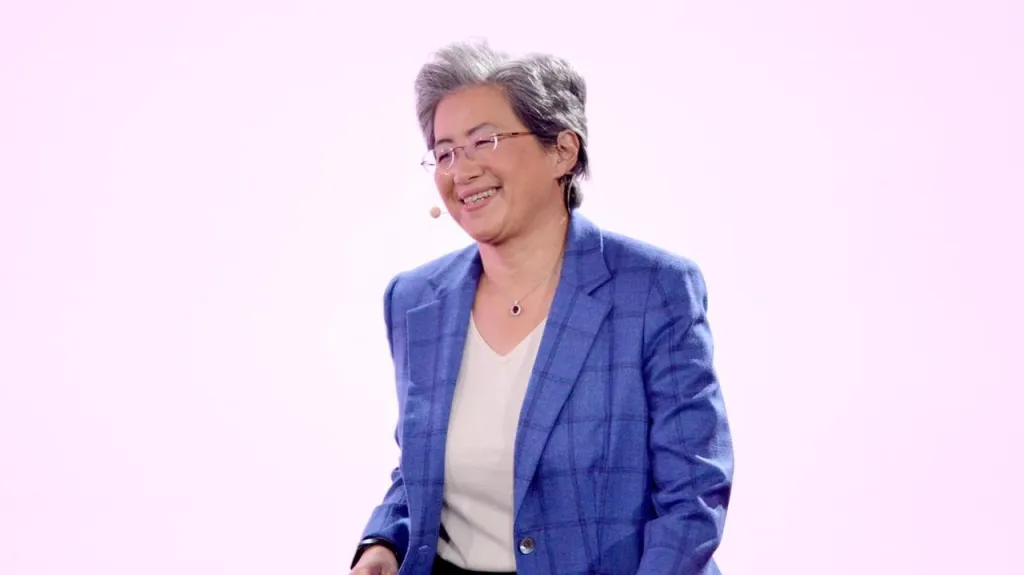Lisa Su's Big Bet: How AMD's CEO changed the AI market
It wasn't AMD that made Lisa Su famous. It was Lisa Su who made AMD what we know today.

In the 1970s in Taiwan, a little girl took apart a radio-controlled car out of curiosity. This was the beginning of a journey that made Lisa Su one of the most influential women in the world of technology companies - the CEO of AMD, the queen of chips.
Half-technician, half-manager: the road to semiconductors
Lisa Su was born in Tainan, Taiwan, in 1969 to statistician Su Chun-hui and accountant Sandy Lo. At the age of three, she moved with her parents to the United States, where her father enrolled in graduate school at the University of Texas at Austin. The family soon moved to New York City. Lisa grew up in Queens and developed a passion for science and technology at an early age, mastering her first programs on a Commodore 64 home computer. Su also loved to disassemble and reassemble radio-controlled cars and other toys, which is how her interest in engineering was born. She later enrolled at Bronx High School for Science, graduating in 1986 .
There, for example, she assembled a miniature model of a hurricane in a box - with boiling water and windows through which she could watch the whirlwind. After high school, Su chose MIT and the most difficult discipline available, as she herself later said, electrical engineering. In the 1990s, she earned three degrees at MIT - a bachelor's, master's and PhD - and found herself in a semiconductor lab for the first time, where she was struck by the idea that a tiny chip could store and process gigantic amounts of data. Her thesis on MOSFET transistors - tiny electronic switches inside computer chips - shaped her future career path.
Semiconductors, which Lisa Su has been working on all her career, are materials that can be customized by making them conduct or not conduct electrical current. This allows chips to turn on, turn off, and perform logical operations. They are the basis of all modern electronics and the brains behind almost all modern technology: phones, computers, cars, the Internet and artificial intelligence systems. Over the past 70 years, chips have changed both everyday life and the economy.
From scientists to managers
After graduating from MIT, Lisa Su gradually moved from research to management roles. Immediately after graduation, in 1994, she took a job as an engineer at Texas Instruments, and in February 1995 she joined IBM. Becoming a leading researcher at IBM's Semiconductor Research and Development Center, she participated in the development of copper interconnects in chips, which replaced aluminum ones. Scientific success was followed by managerial success: she was appointed vice president of the center. Su worked at IBM for more than twelve years, where she was responsible for the strategic development of IBM's silicon technology, joint research with Sony, Samsung, AMD, and, of course, semiconductor development.
In 2007, Su moved to Freescale Semiconductor, a legendary company that has been producing semiconductors since 1949, first as a division of Motorola, then as a separate company, and in 2015 it merged with NPX. On the one hand, Freescale was smaller than IBM, on the other hand, it was at Freescale Semiconductor that Lisa Su first reached the top management level, becoming CTO. In that she is one of the main people in the semiconductor industry professionals have long known.
Rescuing a drowning man
Lisa Su's name became known to the general public when she started working at AMD, and the Times, Bloomberg and WSJ lined up for her interviews. If someone might think that she went from one corporation to another, putting more and more big names on her resume, it should be noted that it was not AMD that made Lisa Su famous. It was Lisa Su who made AMD what we know it to be today. She created one of the most remarkable transformations in technology, taking AMD from near bankruptcy to the forefront of the industry.
AMD (Advanced Micro Devices) is one of the world leaders in the development of semiconductors that are used both in home computers and in huge data centers that provide the work of Google, Meta, Amazon and Microsoft. AMD also makes graphics processing units (GPUs). Unless you live in the woods and have gone to vipassana, you probably use AMD products every day.
From Crisis to Enlightenment: How Zen Saved AMD
Lisa Su joined AMD in January 2012 as a senior vice president, and three years later became the company's CEO. Back then, in October 2014, one AMD share was worth $2.8. Today, it's $235.56 (as of Oct. 9). The company was up to its neck in debt: as of December 31, 2014, it was $2.21 billion with a capitalization of $2.07 billion. Su laid off a quarter of employees, sold the Austin office and immediately rented it back, and restructured, separating expensive chip factories.
Not the least factor in the AMD stock environment was the decline of the personal computer market, with people switching to smartphones and tablets. Lisa was offered to focus on chips for cell phones, but she did something different: she set the team grandiose goals - to create a new generation chip 40% more powerful than the previous one, as well as to make a chip for a supercomputer capable of performing a quintillion operations per second. To keep the company from going bankrupt while engineers work on the new technological marvel, Su signed contracts with the manufacturers of Sony PlayStation and Xbox game consoles to put AMD graphics cards in the devices, and in addition sold a license to some of its developments for a Chinese consortium for $293 million.
It managed to buy time for engineers, in 2016 they created a new generation technology and called it Zen, in 2017 sales of chips under the brand names Ryzen and EPYC started. Zen chips turned out to be so powerful and energy efficient that they began to be used not only in ordinary computers, but also in huge data centers and supercomputers. Gradually AMD began to cooperate with large scientific centers in the United States. Their processors and graphics chips became the basis for the most powerful new generation supercomputers Frontier and El Capitan. Frontier, launched in 2022, is the world's first supercomputer to surpass the exaflops milestone (i.e., performing more than one quintillion operations per second). It runs entirely on AMD chips. El Capitan, unveiled in 2024, is even more powerful and uses AMD processors too. So, Lisa Su has made AMD a leader in research and development of new chips.
Competing with Nvidia and Intel
By 2016, Intel dominated the CPU market, a type of chip that is a central processing unit, the "brain of the computer", with a share of about 85-90% in desktops, while AMD's share barely reached 10-15%. After the development of Zen, AMD's desktop chips overtook Intel in terms of performance/price ratio, and now they have started to gain share in data centers, where Intel used to have almost no competition. AMD's share of the desktop CPU market grew steadily from 2018, rising to 43.3% in 2024 versus Intel's 56.7%. The data center chip market was even more heated: as of 2016, Intel had long reigned supreme with a 98-99% share. Lisa Su not only led AMD into this market, but also wrested away 29.4% of the market through 2024. In processors for mobile devices and laptops, Intel has yet to catch up.
But the real nemesis for AMD was Nvidia. Ma, not only is Nvidia AMD's main rival in strategic markets, but it is run by Lisa Su's great-uncle Jensen Huang. In an interview with Bloomberg's Emily Chang, she explained that he's not really a close relative, not that they don't have family dinners on holidays with plans to remake the market and sarcastic banter, they first saw each other at a technology conference. And they'd have a lot to discuss at a family dinner.
AMD and NVidia are well-known rivals to every gamer (and bitcoin miner) in the GPU (graphics card) market, and more recently in the artificial intelligence field.
Neural networks need special AI chips that speed them up, perform many tasks at once, and still use less power than other chips, saving AI companies' data centers millions of dollars.
In the standalone desktop GPU segment, AMD's situation is crushing: in the second quarter of 2025, Nvidia dominated with about 94% of the market, while AMD got only about 6%, and its share is declining.
AMD's ChatGPT moment: when intelligence meets iron

The relatively new market of AI chips by 2030 is predicted to grow 3.4 times - from $244 billion to $827 billion. Now in this segment NVidia owns more or less stable for the last three years 85.2% of the market, AMD - 14.3%.
But those numbers were before the Open AI deal. On October 6, Lisa Su and Sam Altman announced a deal in which OpenAI agrees to purchase chips from AMD for the equivalent of 6 gigawatts of computing power. In return, OpenAI gets the right to purchase up to 10% of AMD's stock (160 million shares) at $0.01 per share. In practice, as Lisa Su explained to WSJ, this deal will generate tens of billions of dollars in revenue for AMD over the next five years. Nvidia CEO Jensen Huang commented on his distant relative's decision to offer OpenAI 10% of the company in exchange for the partnership in an interview with CNBC:
It's inventive, unique and unexpected. I'm surprised they're willing to give 10% to a company before they've even built their next product. In a way, though, it's really quite a savvy move
Already on October 14, Lisa Su signed another contract: cloud giant Oracle said it will deploy 50,000 Advanced Micro Devices (AMD) GPUs in the second half of 2026, with the collaboration expected to expand in 2027. As CNBC wrote, this was further evidence that cloud providers are increasingly offering AMD GPUs as an alternative to Nvidia's solutions, which dominate the artificial intelligence market.
This article was AI-translated and verified by a human editor
